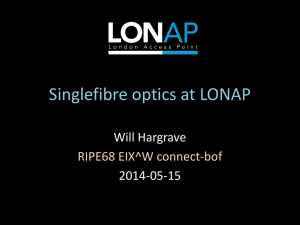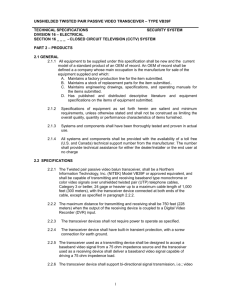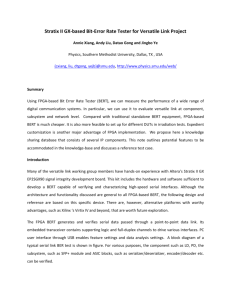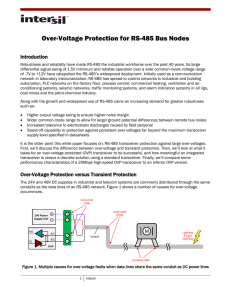display
advertisement
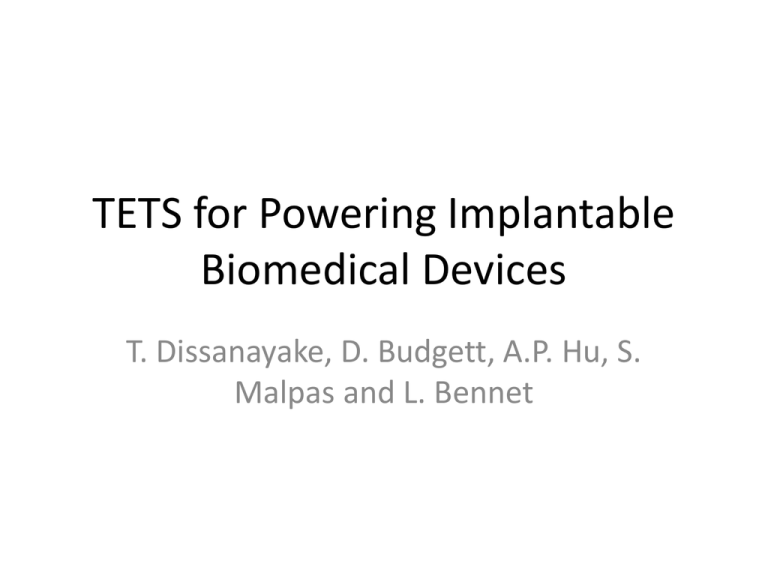
TETS for Powering Implantable Biomedical Devices T. Dissanayake, D. Budgett, A.P. Hu, S. Malpas and L. Bennet Problems • Coupling between internal and external components may vary according to orientation and posture • Insufficient power -- implanted device won’t operate – Charge an implanted battery • Excess power – dissipated heat can cause tissue damage Power Regulation • Internal • Heat dissipation issue • Increased size • Increased weight • External – Preferred – Used in this design Methods of Control • Magnitude Control – Input voltage is varied to vary power delivered to the load • Most common • Problem: mismatch of resonant freq. of the sec. resonant tank and operating freq. of the external power converter • Result: miss-match in freq. reduces power transferred – Increases Vin required – Decreases system efficiency • Frequency Control • Operating freq. is varied to vary power delivered • Tune/detune the secondary pick-up • Effective power delivered is regulated • RF link used to provide wireless feedback from implanted circuit to external freq. controller TETS System Architecture nRF24E1 Nordic Transceivers • Detect DC output voltage and transmit to the external transceiver • The external transceiver processes the data and adjusts the duty cycle of the output PWM signal in order to vary the reference voltage • Response time: 360 ms TETS Design • Internal coil and the resonant capacitor were Parylene coated and encapsulated with medical grade silicon • Implanted total weight: < 100 grams • Secondary coil held on sheep using three loosely tied strings • Displacement – Axial: up to 10 mm – Horizontal: 10 – 20 mm – Power delivered: 5 – 25W (experiment: 10 W) In Vivo Sheep Testing: ΔT = 3.8°C Tmax = 38.4°C Test Time: 24 hours Thermistors measure ΔT Experimental Results P = 10W; V = 23.5V; I = 0.425A Freq. = 163 – 173 KHz ASAIO Journal (1994, vol. 40) Adaptation of Tissue to a Chronic Heat Load • Implanted constant heat flux devices into calves next to lung and muscle tissue – 0.04 W/cm2; 0.06 W/cm2; 0.08 W/cm2 • Initial: – ΔT = 6.4±0.6°C; 4.5±0.2°C; 1.8±0.2°C • After 7 weeks: – ΔT = 3.7±1.2°C; 2.8±0.1°C; 0.8±0.1°C • Adaptive response of the tissue to increase heat dissipation through angiogenesis (development of new blood vessels) nRF24E1-REEL Cost: $5 nRF24E1-EVKIT Cost: $419 Transceiver EVKIT Features • • • • • • • • • • • • • • • • • • Single Chip RF transceiver + MCU + ADC nRF2401 2.4GHz RF transceiver 8051 compatible microcontroller 9 input 12 bit ADC 100Kspls/s Internal voltage regulators Ultra low current drain standby and operation Internal VDD monitoring Supplied in 36 pin QFN (6x6mm) package Mask programmable version available Very few external components Ease of design Data rate 0 to1Mbps Multi Channel operation 125 channels Support frequency hopping Channel switching time <200us. Power supply range: 1.9 to 3.6 V Address and CRC computation ShockBurst™ mode for ultra-low • • • • • • • • • • • • • • • • power operation 0 dBm output power 100% RF tested Complements the nRF2401 transceiver Cuts board space by 80% compared to existing solutions Eases design High reliability No need for external voltage regulator No need for external SAW filter Short time to market Made for volume production - surface mount and RF tested Layout information available for free Package Contains: 2 x nRF24E1 Boards- 2 x USB ConfigBoards Software 2 Antennas There are mainly two types of TET transformers: 1. Iron –core Upside: Little flux leakage No radial or axial misalignment No magnetic flux cross-coupling by the nearby conductor Downside: Difficulty in implantation 2. Air – core Upside: Easy to implantation Downside: Some flux leakage Radial or axial misalignment leads to decreased efficiency even no power output Magnetic flux cross-coupling by the nearby conductor Proposed: Air core transformer to easy implantation, Suggestion: can we put button magnets inside wound coils circle to realize self-alignment of primary and secondary coils both radially or axially? The coils center is filled with polyurethane which also wraps the button magnets inside skin S N S N S N S N skin Charging Circuit Battery DC/AC Converter Primary Coils Secondary Coils Rectifier Battery AMB Amplifier Motor Controller HESA Heart Pump Outside Body Inside Body Further • Current power of the pump needed: 20 W? • What kind of coil to use? How do we choose one? Material? • What electronics needed to make the transceiver work? Difference b/w REEL and KIT. • Which components can be bought, which have to be designed?
